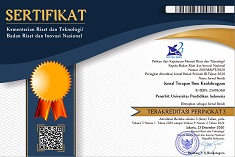Model Latihan Counter Attack Atlet Kumite Cabang Olahraga Karate
Abstract
Abstrak
Tujuan dari penelitian dan pengembangan ini adalah untuk menghasilkan model latihan counter attack atlet kumite cabang olahraga karate. Selain itu, penelitian dan pengembangan ini dilakukan untuk memperoleh informasi secara mendalam tentang: pengembangan dan penerapan model latihan counter attack atlet kumite cabang olahraga karate dan mengetahui efektivitas, efisiensi dan peningkatan keterampilan latihan atlet terhadap model yang dibuat. Penelitian dan pengembangan ini menggunakan metode Penelitian pengembangan Research & Development (R&D) dari Borg and Gall. Subyek dalam penelitian dan pengembangan ini adalah atlet kumite cabang olahraga karate DKI Jakarta sebanyak 40 orang. Instrumen yang digunakan dalam penelitian dan pengembangan ini adalah angket, kuisioner, serta instrumen tes “counter attack” yang digunakan untuk mengumpulkan data tingkat counter attack atlet kumite cabang karaete. Teknik analisis data menggunakan “uji wilcoxon” terdapat perbedaan yang bermakna dari hasil pretest dan posttest model latihan counter attack atlet kumite cabang olahraga karate, diperoleh hasil sig (2-tailed) < 0,05 (sig=0,000) pada taraf signifikansi 0,05 maka hipotesis nol ditolak. Sehingga dapat disimpulkan bahwa, terdapat perbedaan yang signifikan antara pretest dan posttest hasil latihan counter attack atlet kumite cabang olahraga karate, Dari data penelitian, diperoleh hasil rata-rata pretest dengan mean = 36.90, lebih kecil dari pada rata-rata posttest mean = 56.52, Dengan demikian dapat dinyatakan bahwa, model latihan counter attack atlet kumite cabang olahraga karate, efektif digunakan untuk meningkatkan keterampilan counter attack atlet kumite cabang olahraga karate.
Abstract
The purpose of this research and development is to produce a counter attack training model for the kumite athletes in karate. In addition, this research and development was carried out to obtain in-depth information about: the development and application of the counter attack training model of kumite athletes in karate and to find out the effectiveness, efficiency and improvement of the training skills of athletes on the models created. This research and development uses the Research & Development (R&D) development method of Borg and Gall. The subjects in this research and development were 40 DKI Jakarta kumite karate athletes. The instruments used in this research and development are questionnaires, questionnaires, and "counter attack" test instruments which are used to collect data on the counter attack level of the kumite athlete of the karaete branch. Data analysis techniques using the "Wilcoxon test" there were significant differences from the results of the pretest and posttest models of counter attack training exercises for athletes in the karate sport branch, obtained sig (2-tailed) results <0.05 (sig = 0,000) at a significance level of 0.05 then the null hypothesis is rejected. So it can be concluded that, there is a significant difference between the pretest and posttest results of counter attack training in the karate athletes, from the research data, the average results of the pretest with a mean = 36.90, smaller than the average posttest mean = 56.52, Thus it can be stated that, the Kumite athlete branch karate sport counter attack exercise model, is effectively used to improve the skills of the counter attack skills of the Kumite athlete karate sport branch.
Keywords
Full Text:
PDFReferences
Ajay M. Gavkare, dkk (2013) . Auditory Reaction Time, Visual Reaction Time and Whole Body Reaction Time in Athletes. Indian Medical Gazette.
Coskun , B . dkk (2014) . The Comparison of reaction times of karate athlete aaccording to age, gender, and status. Journal Science, Movement, and Healt,.
Croft Ashley. (2009). Intermediate Shotokan karate Unravelling the Brown Belt and First Black Belt Kata. Ramsbury: The Crowood Perss Ltd.
Dawes Jay, dkk (2012) . Developing Agility And Quickness. Amerika Serikat ; National Strength and Conditioning Association.
Dick Walter, Lou Carey, dan James O. Carey,The Systematic Design of Instruction (Ohio: Pearson New Jersey Columbus, 2009),
Griwijoyo Santoso. 2012. Ilmu Kesehatan Olahraga. Bandung: Penerbit PT. Remaja Rosdakarya
Imanudin,Iman. (2014). Modul Mata Kuliah Ilmu Kepelatihan Olahraga. Bandung: FPOK UPI.
Jay dawes, Mark roozen, Developing agility and Quikness (UK: Human Kinetics: 2012)
Koropanovski , N. dkk (2011). Anthopometric and physical performance profile of elite karate kumite and kata competitors. Journal of Human Kinetics, 30/2011,
Leila Nuri . dkk (2013) Reaction time and anticipatory skill of athletes in open and closed skill-dominated sport. European Journal of Sport Science. 13(5).
Philip Vickerman, Teaching Physical Education to Children with Special Educational Needs (USA : Rouledge : 2014)
Sugiyono. (2017). Metode Penelitian Pendidikan (Pendekatan kuantitatif, kualitatif, dan R&D). Bandung : Alfabeta
DOI: https://doi.org/10.17509/jtikor.v4i2.18971
Refbacks
- There are currently no refbacks.
Copyright (c) 2020 Jurnal Terapan Ilmu Keolahragaan

This work is licensed under a Creative Commons Attribution-NonCommercial-ShareAlike 4.0 International License.





